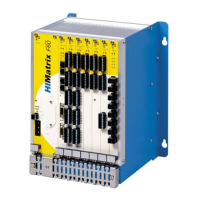System Manual Modular Systems Table of Contents
HI 800 191 E Rev. 2.02 Page 3 of 114
Table of Contents
1 Introduction 9
1.1 Structure and Use of the Document 9
1.2 Target Audience 11
1.3 Formatting Conventions 11
1.3.1 Safety Notes 11
1.3.2 Operating Tips 12
1.4 Service and Training 12
2 Safety 13
2.1 Intended Use 13
2.1.1 Scope 13
2.1.1.1 Application in Accordance with the De-Energize to Trip Principle 13
2.1.1.2 Application in Accordance with the Energize to Trip Principle 13
2.1.1.3 Use in Fire Alarm Systems 13
2.1.2 Non-Intended Use 13
2.2 Environmental Requirements 14
2.2.1 Test Conditions 14
2.2.1.1 Climatic Requirements 15
2.2.1.2 Mechanical Requirements 15
2.2.1.3 EMC Requirements 15
2.2.1.4 Power Supply 16
2.2.2 Noxious Gases 16
2.3 Tasks and Responsibilities of Operators and Machine and System Manufacturers
16
2.3.1 Connection of Communication Partners 16
2.3.2 Use of Safety-Related Communication 16
2.4 ESD Protective Measures 17
2.5 Residual Risk 17
2.6 Safety Precautions 17
2.7 Emergency Information 17
3 Product Description 18
3.1 Modules 18
3.1.1 Inputs 18
3.1.2 Outputs 19
3.1.3 Line Control 19
3.2 Supply Voltage Monitoring 20
3.3 Monitoring the Temperature State 21
3.3.1 Setting the Temperature Threshold for Messages in F*03 Devices 21
3.4 Short-Circuit Reaction of Output Channels 22
3.5 Alarms and Sequences of Events Recording - with CPU 03 22
3.5.1 Alarms&Events 22
3.5.2 Creating Events 22
3.5.3 Recording Events 23
3.5.4 Transfer of Events 23
3.6 Product Data 23

